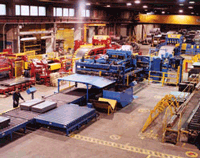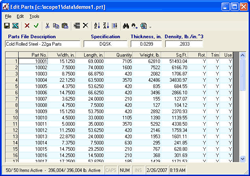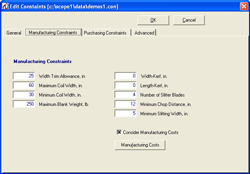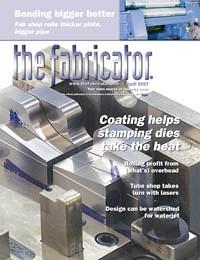- FMA
- The Fabricator
- FABTECH
- Canadian Metalworking
Categories
- Additive Manufacturing
- Aluminum Welding
- Arc Welding
- Assembly and Joining
- Automation and Robotics
- Bending and Forming
- Consumables
- Cutting and Weld Prep
- Electric Vehicles
- En Español
- Finishing
- Hydroforming
- Laser Cutting
- Laser Welding
- Machining
- Manufacturing Software
- Materials Handling
- Metals/Materials
- Oxyfuel Cutting
- Plasma Cutting
- Power Tools
- Punching and Other Holemaking
- Roll Forming
- Safety
- Sawing
- Shearing
- Shop Management
- Testing and Measuring
- Tube and Pipe Fabrication
- Tube and Pipe Production
- Waterjet Cutting
Industry Directory
Webcasts
Podcasts
FAB 40
Advertise
Subscribe
Account Login
Search
Reducing scrap, inventory costs with coil optimization software
Maximize material usage
- By Lloyd Wolf
- April 10, 2007
- Article
- Bending and Forming

Specialized coil optimization software analyzes the parts to be made and determines the optimal coil sizes (widths) to purchase and maintain in inventory. Multicut blanking line photo courtesy of Red Bud Industries, Red Bud, Ill.
Metal fabrication is one of the most competitive industries in the U.S. Fabricators are always looking for new ways to decrease manufacturing costs to maintain profitability and a competitive edge. Identifying and implementing cost-reduction opportunities often mean the difference between long-term survival and plant closure.
Many companies report that raw steel can represent as much as 70 percent of total manufacturing costs. Therefore, reducing scrap and inventory costs are at the center of many cost-reduction efforts. Even the smallest reduction in these costs can have a huge impact on the company's financial bottom line.
Specialized coil optimization software helps analyze the parts to be made and determine the optimal coil sizes (widths) to purchase and maintain in inventory.
The Coil Handling Process
Master coils that fabricators purchase from mills and service centers typically are from 30 to 72 inches wide (see Figure 1). The master coils are decoiled and processed through a series of cut-to-length or multicut blanking operations to yield rectangular blanks.
The process begins when a master coil is loaded onto a cut-to-length or multicut blanking line. As the coil is unrolled, the length is sheared, or cut to length. The blanks generated from the cut-to-length operation are sent to a manual shear, where the coil's width is cut in a secondary shearing operation. The rectangular blanks generated from these operations are then sent to the fabrication, welding, paint, and assembly departments to create the finished part.
If the coil is on a multicut blanking line (a cut-to-length line with slitter blades), the blank's width also is slit at the same time the length is being cut.
The difference between the width of the master coil and the sum of the blank widths across the coil is scrap. It is dumped into a scrap hopper and resold for only a few pennies per pound.
Cutting from master coils can result in inefficient material utilization, because, typically, hundreds of rectangular fabricated parts—each with unique dimensions—must be cut from only a few master coil sizes. To make the math even more complex, each part has its own production requirements: Some parts may be produced in very high volumes—more than 100,000 pieces annually. Other parts may be needed in very low volumes—as few as 100 pieces annually. A coil size that utilizes material efficiently for one part number often is inefficient for another part number.
For example, four 12-in.-wide parts placed across a 48-in.-wide coil results in 100 percent material utilization and 0 percent scrap. However, four 10-in.-wide parts placed across the same 48-in.-wide coil results in about 17 percent scrap. Three 15-in.-wide parts placed across the 48-in.-wide coil results in more than 6 percent scrap.
Many Coils, Many Foils
One method some fabricators use to reduce scrap is to increase the number of different master coil sizes that they purchase and maintain in inventory to increase the chance of maximizing material utilization. Unfortunately, this method of scrap reduction conflicts with just-in-time (JIT) manufacturing and low coil inventory goals. With many different coil sizes in inventory, each coil's usage is reduced. Also, this increases inventory carrying costs, because the coils tend to sit idle in inventory for extended time periods. Purchasing and maintaining numerous different coil sizes also force more frequent setups and changeovers on the cut-to-length line. This is because the more coils that are in inventory, the less likely that the coil required for the next shop order will be the same as the coil required for the last.

Figure 1Master coils 30 to 72 inches wide are processed through a series of cut-to-length or multicut blanking operations to yield rectangular blanks.
In addition, purchasing many coil sizes reduces the purchasing power of volume discounts.
Another method some companies use to reduce material costs is to purchase standard-size master coils, typically 30, 48, 60, and 72 in. wide. These are common sizes, readily available from many suppliers. Accordingly, they are sold for several cents per pound less than the "special"master coil sizes. However, in some instances, this method can be penny-wise and dollar-foolish, because many parts may not fit efficiently into these standard coil sizes. If 5 percent can be saved on the purchase price per pound, then an extra 2 percent or 3 percent scrap might be acceptable. But does it make sense to save 5 percent on the purchase price per pound with a scrap rate that is 10 percent to 15 percent higher than it would be with special master coil sizes?
Manual Calculations
Fabricators try to minimize the amount of scrap they produce by selecting coil sizes that best fit the part sizes. However, for the large number of different part sizes that most fabricators produce, a nearly infinite number of solutions could be considered as to which coil sizes—and combinations of those sizes—;would provide the lowest overall scrap.
Selecting the most desirable coil sizes typically means relying on personal experience or a set of complex manual calculations using spreadsheets. These calculations can take several days or even months to perform, especially when a different set of calculations must be performed for each unique material specification (gauge, grade, chemistry, and so on). Unfortunately, during that time, product line and mix changes may render those results invalid. Also, without having knowledge of complex optimization algorithms, fabricators may base their calculations on invalid assumptions.
Further complicating manual calculations are that purchase prices and part rotation often vary as the coil width changes, because a premium is charged for narrower coils, while discounts are provided for wider coils.
Second, if grain direction does not matter, each part can be considered both with-the-grain and rotated. This factor alone more than doubles the number of possible solutions.
Optimization Software
Specialized coil optimization software can help fabricators attack the problems of high scrap and high inventory. The software analyzes forecast production requirements for a set of parts, manufacturing constraints, and material and manufacturing costs. It determines the optimal coil sizes (widths) to purchase and maintain in inventory, and it shows how to cut parts with lower scrap, lower cost, and fewer coil sizes.
Because of powerful optimization algorithms, the software can effectively consider the cost of every possible combination of coil sizes that can be used—more than could ever be considered manually. It finds the optimal coil sizes, thus reducing scrap loss and the number of different master coil sizes.
Typical Optimization Process
The user starts an optimization study by providing parts and constraint information for the material type to be optimized.
The parts database (seeFigure 2) is a spreadsheet-like window where part blank information is stored for each material specification. Information typically includes part number, width, length, forecast demand, and rotatability. This may be entered directly by the user, copied and pasted from other software, or imported from other systems via file transfer.

Figure 2The parts database stores part blank information—such as part number, width, length, forecast demand, and rotatability—for each material specification.
The costs and constraints database (see Figure 3) is where equipment limits, material costs, and manufacturing costs are specified. Equipment constraints include maximum and minimum coil widths, the quantity of slitter blades, and edge-trim allowance. Using a material cost table, the user can specify the purchase price per pound for varying ranges of coil widths, along with the reimbursement for scrap. Costs for material handling and labor also can be broken out. Constraint information needs to be set up only once for various material specifications and does not require modification for each optimization study.
Once that data is input, the user starts the optimization routine. The software automatically determines the optimal master coil sizes in less than five minutes, typically (see Figure 4). About halfway through the optimization process, the optimal coil sizes are displayed. The user can continue with the optimal master coil sizes, or other sizes may be entered to facilitate "what if"scenarios.
When the calculations are finished, the optimization results can be reviewed both on-screen and in printed reports. The cost and scrap summary report provides summary information such as total scrap, total cost, and total weight for different master coil sizes.
For example, if only one coil size were selected, what would be its width? What would be the scrap rate? What would be the overall cost? If two coil sizes were selected, what would be the width and volume of each, the overall scrap rate, and overall cost? Having more coil sizes will result in less scrap, but other, intangible costs would also increase at the same time, offsetting the material savings. If adding an additional coil size saves an extra $25,000 per year in scrap, that probably makes sense. But if the savings were only an additional $500 per year, then the additional, intangible inventory costs would probably far exceed the material savings.
Using the cost and scrap summary, it is fairly easy to decide on the solution containing the optimal number of master coil sizes to use, considering scrap, material costs, and inventory all together.
Once the number of master coil sizes is decided, a part assignment report can be viewed on-screen or printed. This report shows which parts are assigned to which master coil for the selected solution, and the corresponding number of pieces cut across the coil width. This report typically is used by the engineering department to update bills of materials and routings in the company's manufacturing software system.
Typical Investment, Savings, and Ongoing Periodic Analysis
The initial investment in coil optimization software typically is from $15,000 to $25,000 per manufacturing location—depending on the number of users, the amount of user training, and the need for any customization. Ongoing annual costs for software maintenance and support are typically 15 percent to 20 percent of the initial investment. Depending on the annual steel tonnage the company needs, material costs, and the part mix, annual savings typically are from $30,000 to $200,000. Because operating costs and material costs tend to increase over time, annual savings typically increases too.
Because the mix of parts can change each year, as older product lines are discontinued and new product lines and changes are introduced, the optimal coil sizes also may change. Barring any major product changes, typically a company will use the optimization software to re-evaluate master coil sizes about once each year to see how any changes in part mix have affected the optimal coil sizes. If part demand and mix have changed significantly, different coil sizes likely will be recommended.
If a year from now the results from a new optimization study show that changing two of the four coil sizes for a material specification yields a $25,000 savings, then it probably makes sense to change those sizes. If, however, changing the sizes would produce only a $2,500 savings, meaning that the part mix has not changed much and the prior coil sizes still "fit"the parts fairly well, then it may make sense to simply keep the current sizes, because there will be some cost associated with the time and effort to switch. n
About the Author
Lloyd Wolf
3875 Franklin Towne Court Suite 110
Murrysville, PA 15668
724-325-2900
Related Companies
subscribe now

The Fabricator is North America's leading magazine for the metal forming and fabricating industry. The magazine delivers the news, technical articles, and case histories that enable fabricators to do their jobs more efficiently. The Fabricator has served the industry since 1970.
start your free subscription- Stay connected from anywhere

Easily access valuable industry resources now with full access to the digital edition of The Fabricator.

Easily access valuable industry resources now with full access to the digital edition of The Welder.

Easily access valuable industry resources now with full access to the digital edition of The Tube and Pipe Journal.
- Podcasting
- Podcast:
- The Fabricator Podcast
- Published:
- 04/16/2024
- Running Time:
- 63:29
In this episode of The Fabricator Podcast, Caleb Chamberlain, co-founder and CEO of OSH Cut, discusses his company’s...
- Trending Articles
How to set a press brake backgauge manually

Capturing, recording equipment inspection data for FMEA

Tips for creating sheet metal tubes with perforations

Are two heads better than one in fiber laser cutting?

Hypertherm Associates implements Rapyuta Robotics AMRs in warehouse

- Industry Events
16th Annual Safety Conference
- April 30 - May 1, 2024
- Elgin,
Pipe and Tube Conference
- May 21 - 22, 2024
- Omaha, NE
World-Class Roll Forming Workshop
- June 5 - 6, 2024
- Louisville, KY
Advanced Laser Application Workshop
- June 25 - 27, 2024
- Novi, MI



























